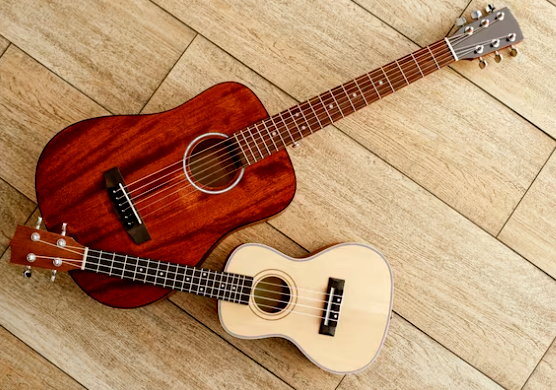The Relationship Between Ukulele and Guitar

If you’re like me you’ve played guitar for a while and it is your primary instrument. But you also dabble in the ukulele. Keeping the two instruments separate is a bit of a challenge – just a bit. Not a major challenge because many of the basic techniques are the same.
But the big difference is that the strings are all tuned differently. So the chords are all fingered differently. Yes, there are four strings, similar to the top 4 strings of the guitar. But the standard Guitar tuning of those 4 strings is D-G-B-E, and for the Ukulele it is G-C-E-A.
Even trying to remember an acronym for the ukulele – like “Grace Can’t Eat Apples” doesn’t help much because I’m never quite sure I’ve got the acronym correct.
I was thinking about this the other night and I realized that there is a very consistent relationship between the notes and chords on the two instruments. The strings on the Ukulele are all tuned exactly 4 notes above those on the guitar.
Guitar: “D” Ukulele: DEF “G”
Guitar: “G” Ukulele: GAB “C”
Guitar: “B” Ukulele: BCD “E”
Guitar: “E” Ukulele: EFG “A”
Same for the chords…
Guitar: “G Chord” Ukulele: GAB “C Chord”
Guitar: “D Chord” Ukulele: DEF “G Chord”
Guitar: “C Chord” Ukulele: CDE “F Chord”
etc.
How does this help you when you’re playing. Well, say you’re playing in the Key of “D” and you need D, G, A, and Bm chords. Assuming you know your guitar chords, you just have to back these off 4 notes.
“D” on the Uke is fingered like “A” on the guitar (ABC D)
“G” on the Uke is fingered like “D” on the guitar (DEF G)
“A” on the Uke is fingered like “E” on the guitar (EFG A)
“Bm” on the Uke is fingered like “F#m” on the guitar (F#GA B)
Obviously this is not perfect. In order to know that last one is F#m rather than Fm requires that you know a bit of music theory.
But it might be a bit helpful. If nothing else it demonstrates how similar the two instruments are, and should help convince you that learning to play the ukulele adds to your overall music knowledge and understanding.



